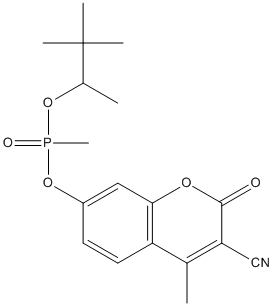PMP-MeCyC
Soman analogue. Fluorogenic organophosphate diesters that produce fluorescence emission upon hydrolysis. The first ester is ethyl (E), isopropyl (I), cyclohexyl (C) or pinacoyl (P) analogous to the structure of VX, Sarin, Cyclosarin, and Somen respectively. The fluorescent ester is 3-cyano-4-methyl-7-hydroxy coumarin (MeCyC) or 1,3-dichloro-7-hydroxy-9,9-dimethyl-9H-acridin-2-one (DDAO)
General
Type : Organophosphate,Flu-OP,Nerve Agent G-series,Surrogate OP,Coumarin,Derivative of Soman,Cyanide
Chemical_Nomenclature : 7-[3,3-dimethylbutan-2-yloxy(methyl)phosphoryl]oxy-4-methyl-2-oxochromene-3-carbonitrile
Canonical SMILES : CC1=C(C(=O)OC2=C1C=CC(=C2)OP(=O)(C)OC(C)C(C)(C)C)C#N
InChI : InChI=1S\/C18H22NO5P\/c1-11-14-8-7-13(9-16(14)22-17(20)15(11)10-19)24-25(6,21)23-12(2)18(3,4)5\/h7-9,12H,1-6H3
InChIKey : FHPKBNXJPLMRFC-UHFFFAOYSA-N
Other name(s) : methylphosphonic acid 3-cyano-7-hydroxy-4-mehtyl-2oxo-2H-coumarin-7-yl ester pinacoyl ester,PMP-Coumarin,3-Cyano-4-methyl-2-oxo-2H-chromen-7-yl 3,3-dimethyl-2-butanyl methylphosphonate,Phosphonic acid, P-methyl-, 3-cyano-4-methyl-2-oxo-2H-1-benzopyran-7-yl 1,2,2-trimethylpropyl ester,3-Cyano-4-methyl-2-oxo-2H-coumarin-7-ylpinacolyl methylphosphonate
MW : 363.34
Formula : C18H22NO5P
CAS_number :
PubChem : 49795037
UniChem : FHPKBNXJPLMRFC-UHFFFAOYSA-N

Target
Families : PMP-MeCyC ligand of proteins in family
ACHE
References (4)
| Title : Evolved stereoselective hydrolases for broad-spectrum G-type nerve agent detoxification - Goldsmith_2012_Chem.Biol_19_456 |
| Author(s) : Goldsmith M , Ashani Y , Simo Y , Ben-David M , Leader H , Silman I , Sussman JL , Tawfik DS |
| Ref : Chemical Biology , 19 :456 , 2012 |
| Abstract : Goldsmith_2012_Chem.Biol_19_456 |
| ESTHER : Goldsmith_2012_Chem.Biol_19_456 |
| PubMedSearch : Goldsmith_2012_Chem.Biol_19_456 |
| PubMedID: 22520752 |
| Title : Directed evolution of hydrolases for prevention of G-type nerve agent intoxication - Gupta_2011_Nat.Chem.Biol_7_120 |
| Author(s) : Gupta RD , Goldsmith M , Ashani Y , Simo Y , Mullokandov G , Bar H , Ben-David M , Leader H , Margalit R , Silman I , Sussman JL , Tawfik DS |
| Ref : Nat Chemical Biology , 7 :120 , 2011 |
| Abstract : Gupta_2011_Nat.Chem.Biol_7_120 |
| ESTHER : Gupta_2011_Nat.Chem.Biol_7_120 |
| PubMedSearch : Gupta_2011_Nat.Chem.Biol_7_120 |
| PubMedID: 21217689 |
| Title : Asymmetric fluorogenic organophosphates for the development of active organophosphate hydrolases with reversed stereoselectivity - Amitai_2007_Toxicology_233_187 |
| Author(s) : Amitai G , Adani R , Yacov G , Yishay S , Teitlboim S , Tveria L , Limanovich O , Kushnir M , Meshulam H |
| Ref : Toxicology , 233 :187 , 2007 |
| Abstract : Amitai_2007_Toxicology_233_187 |
| ESTHER : Amitai_2007_Toxicology_233_187 |
| PubMedSearch : Amitai_2007_Toxicology_233_187 |
| PubMedID: 17129656 |
| Title : Enhanced stereoselective hydrolysis of toxic organophosphates by directly evolved variants of mammalian serum paraoxonase - Amitai_2006_FEBS.J_273_1906 |
| Author(s) : Amitai G , Gaidukov L , Adani R , Yishay S , Yacov G , Kushnir M , Teitlboim S , Lindenbaum M , Bel P , Khersonsky O , Tawfik DS , Meshulam H |
| Ref : Febs J , 273 :1906 , 2006 |
| Abstract : Amitai_2006_FEBS.J_273_1906 |
| ESTHER : Amitai_2006_FEBS.J_273_1906 |
| PubMedSearch : Amitai_2006_FEBS.J_273_1906 |
| PubMedID: 16640555 |